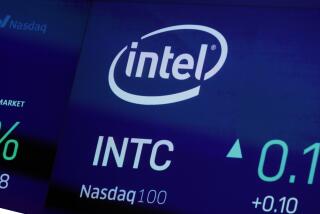Intel to launch potent, efficient chip line
- Share via
SAN FRANCISCO — Intel Corp. plans to roll out its newest generation of microprocessors today, flexing its manufacturing muscle with a sophisticated new approach that crams up to 40% more transistors onto a chip.
The world’s largest semiconductor company plans to start shipping 16 new microprocessors -- which also boast inventive materials to reduce electricity loss -- for use in servers and high-end personal computers.
The most complex chips being launched today have 820 million transistors, compared with the 582 million transistors on the same chip built using the current standard technology. Intel’s first chips, introduced in the early 1970s, had just 2,300 transistors.
Advances in chip technology occur as the infinitesimal pathways that are etched onto the chips shrink further. Intel’s new chips shrink the width of those lines to an average of 45 nanometers, or 45 billionths of a meter, compared with 65 nanometers in the previous generation of chips.
The smaller circuitry allows Intel to squeeze more transistors -- the building blocks of computer chips -- onto the same slice of silicon. That accelerates performance and drives down manufacturing costs.
The transistors on the new chips are so small that more than 30 million of them can fit on the head of a pin. Performance zooms ahead with smaller transistors because more of them are available, they twitch faster to process data and less energy is required to power them.
Perhaps more important, the transistors on the Santa Clara, Calif.-based company’s new chips are built with materials that help solve the crucial problem of electricity loss as the circuitry gets smaller and smaller.
As electricity escapes from the chip, more power is needed to fuel its operations, limiting battery life in laptop computers or increasing electricity costs to run the machines.
“This is more than just a new process shrink,” said Tom Kilroy, general manager of Intel’s Digital Enterprise Group. “Forty-five nanometers is wonderful and we get an uplift, but it really is the reinvention of the transistor.”
Intel, which plans to spend as much as $8 billion on upgrading or building factories for the 45-nanometer chips, is at least six months ahead of smaller rival Advanced Micro Devices Inc. in moving to the new technology.
Intel plans to launch new chips designed for mainstream desktop and laptop computers in the first quarter of 2008. Sunnyvale, Calif.-based AMD, which partners with IBM Corp. on chip-making technology, hopes to start selling its 45-nanometer chips by the middle of next year.
AMD says that its microprocessors have design advantages that keep them competitive with Intel’s best offerings. One of those features is an integrated memory controller, which AMD has long championed.
Intel said only recently that it would begin incorporating the controllers into future generations of chips.
“When you get myopic on the focus on the nanometers in the [central processing unit], you can lose focus on the entire solution,” AMD spokesman John Taylor said.
Intel’s launch today will include server chips with frequencies of 2 gigahertz to 3.20 gigahertz for the quad-core models, which have four processing engines. The clock speed for dual-core models, which have two processing engines, goes up to 3.40 gigahertz. The measurements refer to the chips’ processing cycles, or how fast they can process information.
The server chips will sell for $177 to $1,279 in quantities of 1,000. The high-end PC chip will cost $999 in quantities of 1,000. Intel said all the processors would be available within 45 days.
More to Read
Inside the business of entertainment
The Wide Shot brings you news, analysis and insights on everything from streaming wars to production — and what it all means for the future.
You may occasionally receive promotional content from the Los Angeles Times.










